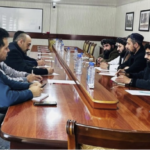The Trump administration has told its top diplomats to seek direct talks with the Taliban, a significant shift in US policy in Afghanistan, done in the hope of jump-starting negotiations to end the 17-year war, The New York Times reported.
The Taliban have long said they will first discuss peace only with the Americans, who toppled their regime in Afghanistan in 2001. But the United States has mostly insisted that the Afghan government must take part.
The recent strategy shift, which was confirmed by several senior American and Afghan officials, is intended to bring those two positions closer and lead to broader, formal negotiations to end the long war.
The shift to prioritize initial US talks with the Taliban over what has proved a futile “Afghan-led, Afghan-owned” process stems from a realization by both Afghan and American officials that President Donald Trump’s new Afghanistan strategy is not making a fundamental difference in rolling back Taliban gains.
While no date for any talks has been set, and the effort could still be derailed, the willingness of the United States to pursue direct talks is an indication of the sense of urgency in the administration to break the stalemate in Afghanistan.
Not long after he took office, Trump reluctantly agreed to provide more resources to his field commanders fighting the Taliban, adding a few thousand troops to bring the total number of America troops to 15,000.
But a year later the insurgent group continues to threaten Afghan districts and cities and inflict heavy casualties on the country’s security forces.
The government controls or influences 229 of Afghanistan’s 407 districts, and the Taliban 59. The remaining 119 districts are contested, according the Office of the Special Inspector General for Afghanistan Reconstruction, which was created by Congress to monitor progress in the country.
Providing more authority to US diplomats, a move that was decided on last month by Trump’s national security aides, is seen as part of a wider push to inject new momentum into efforts to end the war.
Those efforts include a rare cease-fire last month, increased US pressure on Pakistan to stop providing sanctuary to Taliban leaders and a rallying of Islamic nations against the insurgency’s ideology. Grassroots peace movements in the region have also increased pressure on all sides.
Over the past few weeks senior American officials have flown to Afghanistan and Pakistan to lay the groundwork for direct US-Taliban talks.
US Secretary of State Mike Pompeo briefly visited the Afghan capital, Kabul, last week, and Alice G. Wells, the top diplomat for the region, spent several days holding talks with major players in Afghanistan and Pakistan.
Efforts have particularly focused on trying to persuade the Afghan leadership that such talks are not a replacement for negotiations with the country’s coalition government, but are meant to break the ice and pave the way for those.
Because the previous Afghan government felt left out of peace efforts during the Obama administration, it resisted direct talks, which was one reason peace efforts at that time collapsed.
Neither the State Department nor a Taliban spokesman would comment on the shift of policy toward engaging the Taliban directly.
President Ashraf Ghani of Afghanistan said last month at a news conference that the peace process would be a complicated, layered effort rolled out in phases that were still in the preparatory stage. He left open the possibility of a more direct US role in the early efforts.
“Various ideas, creative ideas are floating on how to break this logjam and get started,” Ghani said.
Douglas E. Lute, a former ambassador to Nato who advised Presidents Barack Obama and George W. Bush on Afghanistan, said he supported the new marching orders for US diplomats, although he was not privy to deciding on them.
“We’re in diplomatic gridlock right now,” Lute said. “We ought to look for creative ways to move this forward.”
White House orders direct Taliban talks to jumpstart intra-Afghan dialogue

Leave a Comment












